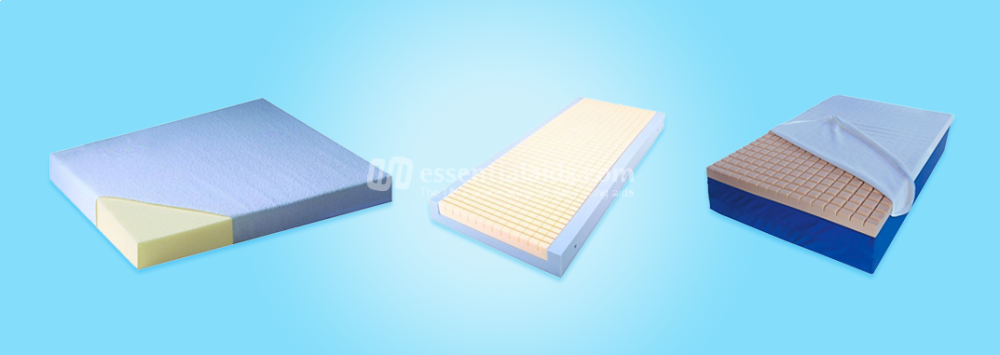
Invaluable Support from the Pressure Relief Mattress
Sally Madeley-Carr, OT04 Mar 2021
What is a pressure sore?
Pressure sores, also known as pressure ulcers and bed sores, happen when pressure is put onto a particular part of the body over a prolonged period.
Individuals commonly affected include people who sit for long periods of time, spend too much time in a wheelchair, or spend a lot of time in bed (at home, or in a care home or hospital).
Lack of movement can cause injuries to the skin and to the underlying tissue.
Restriction to blood flow
Pressure over a prolonged period of time affects the flow of blood in the compressed area and could lead to that skin becoming damaged, or even cause degeneration.
Restriction to blood flow means the white blood cells can't get through to fight off infection.
The compressed skin then has no health defence mechanism in that area. The skin may become infected with bacteria and could quickly develop into something more serious.
What prevents restful sleep?
Even for fully active people, a poor quality mattress can result in a poor night's sleep.
This is because inadequate support to the whole of the body means the spine may not be correctly aligned.
This could lead to too much tossing and turning during the night and immediate discomfort the next day.
We all need to find the best position to induce restful sleep, including lying on the back, on the stomach and on the side, as well as lying straight or curled up.
A poor quality mattress means that our bones will meet the mattresses at points such as the head (and even the ears), shoulders, hips and the feet.
The fleshy parts in between will be hovering above the mattress support, putting pressure on the bony areas to take on this excess weight.
The bones taking on the weight of the whole body are where the most pressure is being applied and where bed sores most commonly appear. A good quality mattress will therefore allow some give and take to the user, allowing more of the body to benefit from a good night's sleep.
Bed Sore Identification
These sores can be measured as:-
Grade 1 - reddening of the skin, usually over a bony area
Grade 2 - blister-like wounds represented as a shallow ulcer in a pink wound area
Grade 3 - skin damaged, as well as the tissue under the skin, maybe exposing subcutaneous fat but no muscle, tendons or bone
Grade 4 - deep damage, including exposed muscle, tendon, bones and joints.
The Braden Scale
A control measure, known as the Braden Scale, addresses six personal points to measure the elements of risk between low and high pressure bed sores.
These are activity, mobility, sensory perception (whether the individual can feel discomfort or pain), moisture (assessing how much moisture the skin is usually exposed to), friction and shear.
Whilst pressure sores may come on gradually, they can indeed be evident within only a few hours.
Pressure also comes in different forms:
- Interface pressure is caused by the weight of the whole body or a limb applying its own weight onto a hard surface and remaining still over a prolonged period.
- Shear pressure is when layers of skin rub over other layers of skin. For example, obesity may cause shear pressure between the legs when walking
- Friction pressure happens when something rubs against the skin. Examples include a badly-fitting garment or an unsuitable mattress.
Pressure sores can affect all parts of the body. They may often start as what looks like discolouration of the skin.
They can then quickly develop into open wounds exposing bone and muscle. If not monitored, these can become serious and even life-threatening.
Who's most at risk?
Individuals most at risk include those with reduced mobility, malnutrition, vascular disease, illness, or a level of consciousness which leaves them immobile.
It can also include people who are overweight, those of senior age and also some who have a sensory impairment (the person's inability to sense and react to discomfort and pain).
Certain illnesses can make skin fragile or affect blood supply, including diabetes and multiple sclerosis.
Pressure sores are a common risk in care homes. It is so important to maintain correct procedures for preventing, or quickly identifying, this condition. Vigilant care can be supported by both dedicated training and the use of appropriate mobility aids.
The Pressure Relief Mattress
In care homes for the elderly, nursing homes and homes for people with mobility disabilities, the service users will be less active than those in the wider community. Finding the right mattress will play a major part in making sure that bed sores are kept at bay.
Mobility aids come in all shapes and forms.
In the case of a pressure relief mattress, the seriousness of bed sores is one of the points which are being addressed in caring for the individual and helping to maintain comfort and quality of life.
These specialist mattresses are designed to reduce pressure on the main bed sore points.
Choosing the right mattress to make sure the user is as comfortable as possible is such an important part of care.
The right choice of mattress will address the grade of bed sore and therefore apply the correct bed support needed.
By applying active pressure relief at the appropriate points, bed sores can be both prevented and safely handled.
Types of Relief Mattresses
There are three different types of mattress which provide pressure relief. These are the static foam mattress, the alternating air flow mattress and the hybrid combination mattress.
The static foam mattress is made of either single or multiple foam and its reactive surface is designed to respond to the individual's body weight, temperature and movement.
This mattress is classed as a low-tech CLP (continuous low pressure) support device. The castellations (risen sections with spaces in between) and the air pockets in the design both contribute to reducing pain and tackling bed sores.
Designed mostly for the prevention of bed sores rather than their treatment, static foam mattresses are for those with grade 1 and grade 2 types of bed sore. With this design, carers still need to reposition the user every two hours.
The alternating air flow mattress has an active lying surface and this pressure relief mattress redistributes pressure throughout its surface.
It is made up of a row of cells which alternate their function between either applying or relieving pressure.
An air pump, which is usually attached to the bed base, is responsible for both inflating and deflating alternate air cells. The inflated ones provide pressure, whilst the deflated ones promote relief.
The air passing through the mattress also keeps the user's contact with the mattress both cool and dry.
This mattress type would be used to prevent ulcers developing and to treat any that may have already begun to develop.
The lying surface can sometimes cause a little discomfort. For grade 3 and grade 4 ulcers, it is advisable to alternate the relief mattress used.
The hybrid combination mattress is, in essence, a combination of the static and the alternating airflow styles.
By incorporating both alternating air cells and a foam topper, this hybrid promises optimum pressure relief and a high degree of comfort.
The hybrid also needs a mains-powered pump for operating the air cell function.
This type of relief mattress is perfect for those at a high risk of developing bed sores, even though these individuals may still have some range of mobility.
The work done by the hybrid combination mattress is to constantly relieve pressure over the whole body. This reduces the need for carers to reposition the user quite so often, thus promoting a better quality of sustained sleep.
NICE (National Institute for Health Care Excellence) guidelines state that a pressure relief mattress is an essential piece of equipment for managing bed sores. This does not, however, negate the need to reposition the user at times.
Summary
Guidelines for quality care show that using the most appropriate mattress for people who are no longer fully active due to their personal condition is paramount in preventing and tackling bed sores.
These ulcers can show up in as little as two hours and are most commonly found on the bony pressure points in the body, though they can also be found on the ears. However, attention must still be given to the whole body and not just the bony areas.
If not addressed immediately, a bed sore can quickly develop into something extremely serious. An unattended infection could even lead to death, due to the blocked white blood cells being unable to flow to the points affected.
Keeping bed sores at bay promotes the comfort of the individual, aids restful sleep and maintains quality of life.
NOTE : When using a pressure relief mattress on a bed which also offers bed rails, care must be taken in addressing the height (thickness) of the mattress used.
One must take into consideration the height of the bed rail and the purpose for which the bed rails are there.
Reducing the clearance height of the bed rail to only that which is over and above the added height of the mattress could inhibit the bed rail purpose of preventing bed falls.

Sally Madeley-Carr, OT
Sally qualified as an Occupational Therapist in 1996 and is a well-respected professional in the field of rehabilitation equipment and living aids. She has worked in private practice and within the NHS, developing a broad experience with adults and children. Click here for Sally's registration with the Health and Care Professions Council. The HCPC regulates health, psychological and social work professionals in the UK.